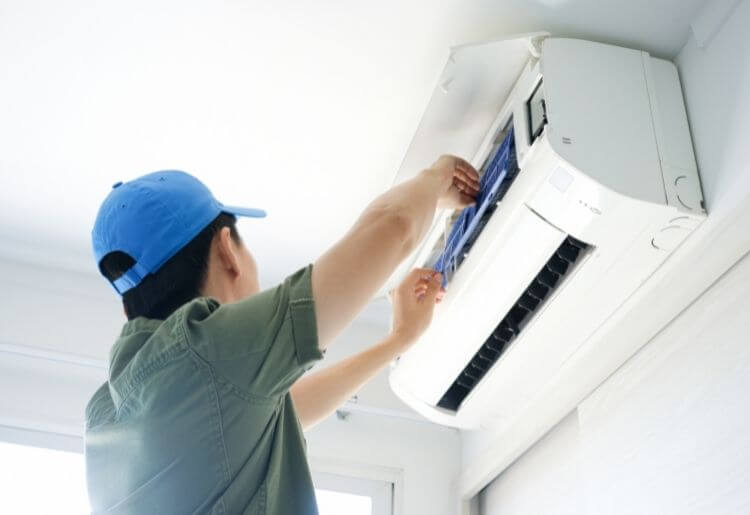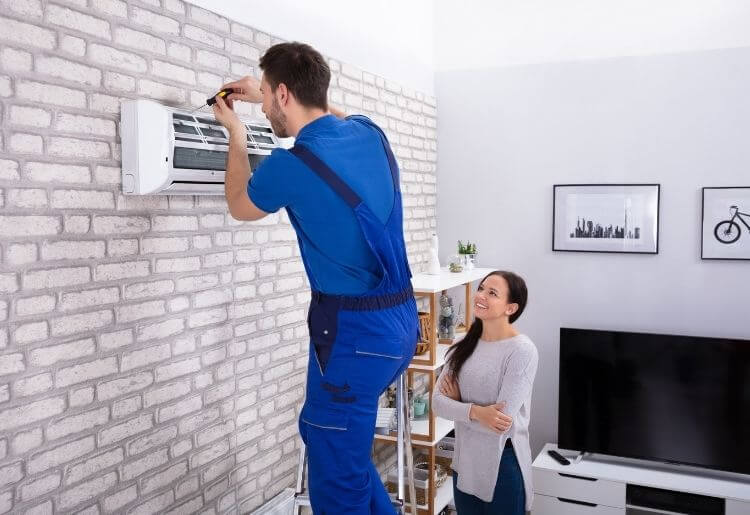Unfortunately, these systems are complicated. Even figuring out what needs to be done to keep on top of any issues can feel like a huge challenge—so we put together this list of HVAC maintenance tips.
Our HVAC tips for homeowners will help you determine a list of maintenance tasks, how often they need to happen, and how a home warranty can protect you if the worst does happen.
1. Keep the area around your HVAC unit clear
One of the easiest things you can do to make sure your home’s heating and cooling system runs smoothly is to keep the surrounding area free of debris, furniture, plants, and other obstructions. Any object placed close to your HVAC unit can obstruct airflow, decreasing energy efficiency and forcing your HVAC system to work harder than it needs to.
This applies to outdoor components, such as air conditioning condensers, and indoor components like your furnace. Indoors, keep furniture, plants, and other objects at least 2 feet away from any HVAC components. Outdoors, keep two feet around any HVAC components clear of vegetation, sticks, and dirt.
Keeping your HVAC system unobstructed means more than just removing nearby objects. To maintain good energy efficiency and high air quality, you will also need to keep the system clean by removing accumulated dust and debris from ducts, supply vents, filters, supply and return registers, and other areas you can easily reach.
2. Clean outdoor equipment regularly
A dirty HVAC system is more than just a drain on your wallet: it is a hazard to you and your family. The air running through it will accumulate contaminants and, in extreme cases, can even spread toxins or bacterial infections throughout your home. That’s why it is a good idea to clean your HVAC system regularly.
Outdoor equipment, such as the condenser for your air conditioner, or the outdoor portion of the heat pump, will need cleaning more frequently. Before cleaning, turn off the power to your outdoor unit. Brush away any accumulated detritus on the unit’s exterior, paying particular attention to any vents that take air in or out. Trim any branches, shrubs, bushes, or grass in a two-foot area around the HVAC unit.
3. Clean indoor equipment occasionally
Dust and other debris will accumulate more slowly indoors, but it still affects your HVAC system's overall efficiency and sanitation. Be sure to check for dust buildup on your HVAC system’s components and clean them regularly.
Air conditioning units require an additional step. Once a year or so, you will need to clean your air conditioner's condensate drain with bleach to remove any impurities that may otherwise build up and clog it, causing water to build up inside your cooling system.
To clean a condensate drain, shut off your air conditioning unit and detach the drain line. Then, pour a cup of bleach into the drain to clear any organic buildup. Consult your system’s owner's manual to disconnect the drain line safely.
4. Replace the filters when they get dirty
At its core, your HVAC system works by sucking in air, then heating or cooling it as needed. To do this effectively, its air filters require regular replacing. While most manufacturers will offer guidelines for how often to replace your air filters—usually every 90 days—the actual timing will vary widely based on air quality. If your area regularly experiences wildfire smoke, volcanic ash, or other airborne contaminants, you may need to replace the filter much more frequently.
You can perform an easy visual inspection to determine if your filter needs replacement. Once a month, take out the air filter and hold it up in front of a light. If you cannot see the light through the filter, it is time to replace it. If the filter fails your visual inspection, replace it early, but always replace it by the 90-day mark.

5. Keep a regular HVAC maintenance schedule
We covered a lot in the first four points. That's why it's a good idea to keep a simple schedule in place that reminds you when and how to care for your HVAC system. Feel free to make your own, or go ahead and steal ours.
Monthly
Check for debris, dirt, or vegetation on or around outdoor HVAC components.
Check for dust buildup and obstructing objects around indoor HVAC equipment.
Perform a visual inspection of your air filters and replace them as necessary.
Inspect your carbon monoxide detectors and replace any dead batteries.
Seasonally
Replace your air filters according to the manufacturer's instructions if you did not have to do so sooner.
Schedule a professional inspection.
Yearly
Clean your air conditioner's condensate drain line with bleach.
Replace all batteries in the carbon monoxide detectors in your home.
6. Practice preventative maintenance to save money
You may have noticed that we recommended a professional inspection in our maintenance schedule. In addition to everything you can do yourself, it is essential to have your system inspected by a professional at least twice a year: once in time for the switch from heat to AC for summer, and another time for the switch back.
The professional will perform a whole host of tasks that can be challenging or dangerous to do on your own, such as checking the electrical connections, lubricating moving components, inspecting capacitors, etc. Though individual prices vary, you can expect a typical inspection to cost about $75-$150.
Before inviting anyone to your home, you may want to read our guide on how to make sure an HVAC specialist is legitimate, and educate yourself on the top tips for saving money when using an HVAC professional.
7. Avoid expensive repairs with regular maintenance
Spending $75 to $150 twice a year can seem costly, but staying on top of your maintenance helps prevent a whole host of issues, including ignition problems, thermostat malfunctions, overheating, and water leaks.
Replacing a damaged thermostat can easily cost $150+ on its own, while other more advanced components can cost hundreds or even thousands of dollars. And replacing your entire HVAC system can easily set you back $7000 to $10,000. Therefore, investing a little time and money in preventative maintenance will save you a tremendous amount in the long run.
You can drive your costs down further by signing up for a home warranty plan that covers HVAC systems. Choice, for instance, offers affordable plans that cover you in case of failures of all major appliances, including HVAC, refrigerators, central vacuum systems, and more.
If you want an affordable plan specifically for HVAC systems, AFC Home Club’s Bronze plan is an affordable solution that does not require an inspection of your equipment as a condition for signup. Due to the minimal hassle on registration, this plan is perfect for landlords looking to protect a tenanted property.
8. Monitor your energy costs
In addition to your regular monthly checks, watch your power bill for sudden increases. Decreased energy efficiency caused by a damaged component can force your HVAC system to work harder than usual to heat and cool your home, draining additional power.
If you spot an unexplained increase, check the air filters and the condensate drain and remove any obstructions around your HVAC equipment. If next month the problem remains unresolved, call a professional.
9. Check for leaks
While inspecting your HVAC system, if you notice any fluid buildup near the unit or hear any escaping air, this could be evidence of a leak. Leaks are always an issue. If you are not comfortable patching a leak yourself, contact a professional and inform them of the issue.
Often, however, you can easily fix a leak using weather stripping or caulk. First, locate the site of the leak. Next, apply a strip of weather stripping adhesive to it. Press it gently at first, then push it in more firmly to secure it once you see that the system is no longer leaking. For more minor or irregularly shaped leaks, apply a little caulk to the gap instead.
10. Invest in good insulation
If you have poor insulation in your home, the best HVAC system in the world will have trouble keeping up. According to the Department of Energy, about 29% of your utility bill goes to heating. This amount can easily double in an uninsulated home and will be higher in an improperly insulated one.
One term that you will hear thrown around a lot when talking about insulation is R-Value. The more insulated your home is, the higher its resistance, or R-Value. If your home’s R-Value is sufficient for your climate zone, your HVAC system should have no trouble keeping you warm in the winter and cool in the summer. You can use this Home Energy Saver calculator to determine, by zip code, what the recommended R-Value is for homes in your region.
Conclusion
There are a number of steps you can take as a homeowner to care for your HVAC system. Implementing a schedule of regular cleaning, filter changes, and visual inspections is essential if you want your HVAC system to last. In addition to your own efforts, it is crucial to hire a professional for biannual checkups to ensure that the complicated internal components of your HVAC system are running smoothly. And consider getting a home warranty to cover any catastrophes.
Take good care of your HVAC system, monitor your power bill and equipment for leaks, and invest in sound insulation. If you follow these steps, you should have no trouble maintaining a comfortable temperature in your home, no matter the weather.
